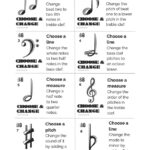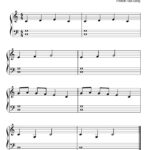The educational value of notating an original composition in Noteflight is far beyond a thousand theory assignments. Unfortunately, novice composers often get stuck somewhere in the process. Getting stuck is what Melanie Meehan calls “the gum in the straw.” Melanie Meehan is the author of three books about teaching elementary writing. She is a main contributor to the blog called The Two Writing Teachers. I first heard about Melanie as a guest on the Cult of Pedagogy Podcast in the episode “How to Use Backward Chaining to Differentiate Instruction.” To help her students get unstuck and become better writers, Meehan recommends backward chaining. This specific kind of scaffolding has students begin a task closer to the end rather than starting it from the beginning. Occupational therapists frequently encourage kids to complete the last stage of a task which allows them to end in success. As children develop confidence and skills, they can “take over” earlier steps in the sequence. Learn more here.
Meehan claims, “There’s no telling where the gum in the straw might be for somebody getting stuck doing something, so finding it may require assessment and experimentation.” The starting point depends on the steps involved and students’ particular needs. For students learning how to write a research paper, it may begin with choosing a topic, gathering information, or summarizing the main points.
A meal kit service like HelloFresh is a cook’s form of backward chaining, and it definitely met my particular need! HelloFresh offers recipes and ships pre-measured ingredients with clear instructions on preparing each meal to my doorstep. This service puts me a few steps closer to the end of the meal prep and takes grocery shopping–MY gum in the straw–out of the sequence.
So how can backward chaining be applied to notating an original piece in Noteflight? Considering the steps involved, there are plenty of places for students to get stuck when composing: where to begin, harmonizing a melody, transitioning to a new section, to name a few, and of course, how to notate it. Since notation is the final step in the composition process, the following sequence shows how to help students gain confidence in using Noteflight first. It begins with the end–the notation–then backtracks using creative prompts I call Choose and Change Cards and Choose and Add Cards. These steps shift the composing process in reverse by offering ideas for creative decision-making after the initial notation.
In essence, students follow a recipe:
- Learn to use Noteflight by copying a piece already notated.
- Follow the suggestions of the Choose and Change Cards that change the original.
- Follow the suggestions of the Choose and Add Cards that broaden the choices and nudge students to flex their creative muscles.
For this backward chaining, I purposely chose a simple tune, “Are You Sleeping” and then notated it in Noteflight. You can download the PDF here. Then, ask students to notate the piece so it looks as similar to the PDF as possible. If students are new to using Noteflight, assign them to watch this video to learn how to use Noteflight.
If you like, create a template with blank measures and share it in your Noteflight Community. Ask students to save a copy, and they can copy the notation without starting from scratch. If you have a Noteflight Learn account, you can make a blank template and share it with your students.
After they duplicate the short piece, encourage students to change up their score by following the suggestions on the Choose and Change Cards. (Download the PDF here, consider laminating and cutting the cards to make a small deck.) The cards ask students to choose a line, measure, or pitch and then change something. Choices give students ownership and “permission” to explore. The suggestions on the cards test students’ comprehension of theory concepts like pitch recognition, rhythmic notation, modes, and much more. This really is a two-for-one assignment!

After getting over the hurdle of notating a piece in Noteflight, students see that manipulating the original tune by changing it or adding to it leads to something original. Research shows that the human brain does not like new or hard. Backward chaining minimizes the “pain” of creating and notating new music.
Keep in mind that backward chaining is not a permanent solution. Meehan advises:
“Scaffolds, by definition, should be temporary, and there should be a plan to take them away. I am intentionally and purposefully doing work for kids, but with the idea that they are going to build their confidence, they are going to build their competence, they’re going to build their curiosity around the whole process, and they’re going to become more willing to go backward in the process to an earlier step.”
As you gradually move the starting point back in the composition process, continue to offer choices. A blank page, 12 tones, and 88 keys are intimidating. Encourage musical imaginations to stick within limitations like chord progressions or the pentatonic scale. As students flex their creative muscles within a “safety net,” they’ll experience success. That success builds confidence, and they’ll feel the urge to step out of the “safe zone.” That’s when creativity skyrockets and novice Noteflight users get hooked–not stuck–on composing.
Leila Viss
Leila Viss is known for her innovative teaching methods incorporating technology and creativity. Her imaginative instructional resources inspire students and teachers. Viss is the past coordinator for the University of Denver’s Piano Preparatory Program and offers Composiums that guide teachers to nurture their creative voice through composition and arranging. Viss is known internationally for her innovative and engaging presentations and is a longtime church organist and pianist. Viss is Colorado’s 2024 Foundation Fellow, Music Teachers National Association.
Site: LeilaViss.com
Composium: https://www.leilaviss.com/composium
Facebook: https://www.facebook.com/88pianokeys/
Instagram: https://www.instagram.com/leilaviss/



